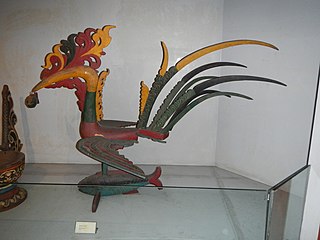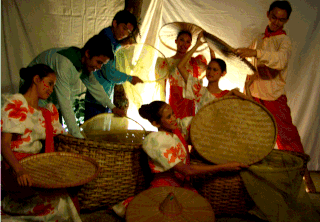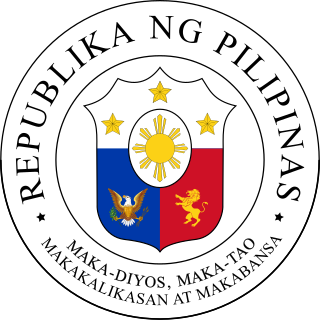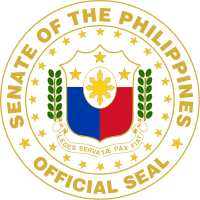
The Coat of arms of the Philippines or sometimes in features the eight-rayed sun of the Philippines with each ray representing the eight provinces which were placed under martial law by Governor-General Ramón Blanco during the Philippine Revolution, and the three five-pointed stars representing the three primary geographic regions of Luzon, Visayas, and Mindanao.

The flag of the state of Michigan depicts the state's coat of arms on a dark blue field, as set forth by Michigan state law. The state has an official flag month from June 14 through July 14.

The coat of arms of Puerto Rico was first granted by the Spanish Crown in 1511, making it the oldest heraldic achievement still currently in use in the Americas. The territory was ceded by Spain to the United States in accordance to the peace treaty that ended the Spanish–American War in 1899, after which two interim arms were adopted briefly. A law was passed in 1905 that re-established the historical armorial bearings as the arms of the territory; after numerous investigations and amendments, the current version was adopted in 1976.

The Senate of Virginia is the upper house of the Virginia General Assembly. The Senate is composed of 40 Senators representing an equal number of single-member constituent districts. The Senate is presided over by the Lieutenant Governor of Virginia. Prior to the American War of Independence, the upper house of the General Assembly was represented by the Virginia Governor's Council, consisting of up to 12 executive counselors appointed by the Colonial Royal Governor as advisers and jurists.

The Seal of the President of the Philippines is a symbol used to represent the history and dignity of the President of the Philippines. Its original form was designed by Captain Galo B. Ocampo, Secretary of the Philippine Heraldry Committee, and patterned after the Seal of the President of the United States. It was first used by President Manuel Roxas in 1947.

The Great Seal of the State of Mississippi was adopted in 2014, replacing the previous version that was used since the 19th century.

The Great Seal of the State of Missouri was adopted on January 11, 1822. Judge Robert William Wells designed the seal. The center of the seal contains the Great Seal of the United States on the right side, and, on the left, symbols representing the state. On both sides of the center circle, a bear represents strength and bravery; a crescent moon represents the newness of statehood and the potential for growth. Surrounding these symbols is the motto "United we stand, divided we fall". The belt buckle signifies the State's ability to secede from the Union if deemed necessary, i.e., the belt can be unbuckled. Two mighty grizzly bears support this center shield. A scroll carries the state motto, Salus populi suprema lex esto, a Latin phrase meaning "Let the welfare of the people be the supreme law." The year 1820 is inscribed in Roman numerals below the scroll, although Missouri was not officially granted statehood until 1821. A star representing each of the other states of the Union graces the top portion of the seal. The outer circle of the seal bears the words "The Great Seal of the State of Missouri". Above the shield is a helmet representing Missouri's state sovereignty. The large star above the helmet surrounded by 23 smaller stars represents Missouri's status as the 24th state. The cloud around the stars indicates the problems Missouri had in becoming a state.

The Sarimanok is a legendary bird of the Maranao people who originate from Mindanao, an island in the Philippines. It comes from the words "sari" and "manok." "Sari" means cloth or garment, which is generally of assorted colors. manok means "chicken".

Jasminum sambac is a species of jasmine native to a small region in the eastern Himalayas in Bhutan and neighbouring Bangladesh, India and Pakistan. It is cultivated in many places, especially across much of South and Southeast Asia. It is naturalised in many scattered locales: Mauritius, Madagascar, the Maldives, Cambodia, Indonesia, Christmas Island, Chiapas, Central America, southern Florida, the Bahamas, Cuba, Hispaniola, Jamaica, Puerto Rico, and the Lesser Antilles.

The Elections for the Malolos Congress, also known as the Revolutionary Congress were held in the Philippines from June 23 to September 10, 1898.

The national symbols of the Philippines consist of symbols that represent Philippine traditions and ideals and convey the principles of sovereignty and national solidarity of the Filipino people. Some of these symbols are stated in the Flag and Heraldic Code of the Philippines, which is also known as Republic Act 8491. In the Constitution of the Philippines, the Filipino language is stated as the national language of the Philippines. Aside from those stated symbols in the Constitution and in Republic Act 8491, there are only six official national symbols of the Philippines enacted through law, namely sampaguita as national flower, narra as national tree, the Philippine eagle as national bird, Philippine pearl as national gem, arnis as national martial art and sport and the Filipino Sign Language as the national sign language.

The Distinguished Service Star is the third highest military award of the Armed Forces of the Philippines. It is awarded for eminently meritorious and valuable service rendered while holding a position of great responsibility.

The coat of arms of Pennsylvania is an official emblem of the state, alongside the seal and state flag, and was adopted in 1778. The flag of the Commonwealth of Pennsylvania consists of a blue field on which the state coat of arms is embroidered. The Pennsylvania coat of arms features a shield crested by an American bald eagle, flanked by horses, and adorned with symbols of Pennsylvania's strengths—a ship carrying state commerce to all parts of the world; a clay-red plough, a symbol of Pennsylvania's rich natural resources; and three golden sheaves of wheat, representing fertile fields and Pennsylvania's wealth of human thought and action. An olive branch and cornstalk cross limbs beneath—symbols of peace and prosperity. The state motto, "Virtue, Liberty and Independence", appears festooned below. Atop the coat of arms is a bald eagle, representing Pennsylvania's loyalty to the United States.
The coats of arms of the U.S. states are coats of arms, adopted by those states that have chosen, that are an official symbol of the state, alongside their seal. Eighteen states have officially adopted coats of arms. The former independent Republic of Texas and Kingdom of Hawaii each had a separate national coat of arms, which are no longer used.

In heraldry, the term sea-lion refers to a legendary creature that has the head and upper body of a lion, but with webbed forelimbs and a fish tail. These occur most frequently as supporters, but also occur as crests and occasionally as charges. Sea-lions are frequently found in "sejant" or "sejant-erect" attitudes, but may also be found "naiant" or "assurgeant".

Maka-Diyos, Maka-tao, Makakalikasan at Makabansa is the national motto of the Philippines. Derived from the last four lines of the Pledge of Allegiance to the Philippine Flag, it was adopted on February 12, 1998 with the passage of Republic Act No. 8491, the Flag and Heraldic Code of the Philippines, during the presidency of Fidel V. Ramos. Its adoption came twelve years after the abolition of the country's previous motto, "Isang Bansa, Isang Diwa", which was adopted during the presidency of Ferdinand Marcos in 1979.

The Seal of Manila is composed of the city's modern coat-of-arms, with colors mirroring those of the National Flag. It is a modified form of the city's historical arms bestowed in the 16th century.

The Seal of Bulacan is one of the official symbols of the province of Bulacan in the Philippines.

The Great Seal of the Philippines is used to authenticate official documents of the Philippine government. It may refer to the physical seal itself or the design impressed upon it. Under the law, the President of the Philippines is given the custody to the seal.


















